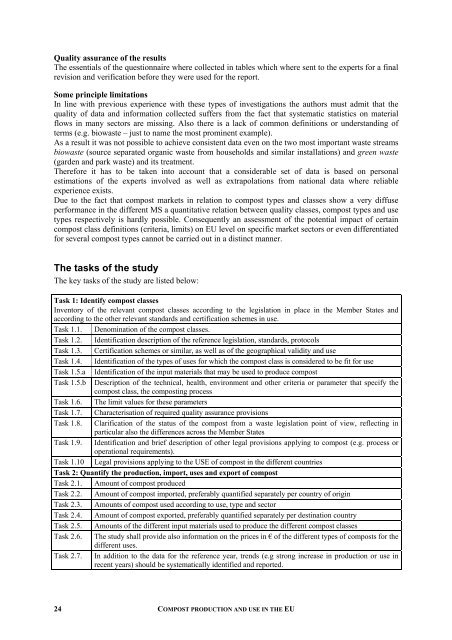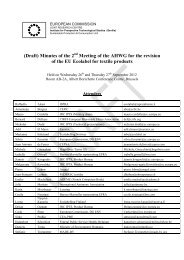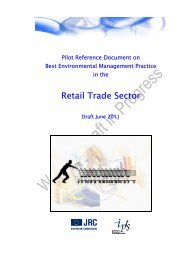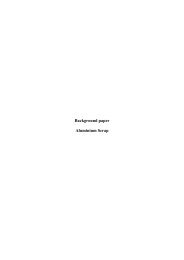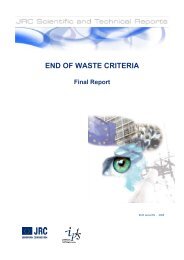final report - JRC IPTS - Sustainable Production and Consumption ...
final report - JRC IPTS - Sustainable Production and Consumption ...
final report - JRC IPTS - Sustainable Production and Consumption ...
You also want an ePaper? Increase the reach of your titles
YUMPU automatically turns print PDFs into web optimized ePapers that Google loves.
Quality assurance of the results<br />
The essentials of the questionnaire where collected in tables which where sent to the experts for a <strong>final</strong><br />
revision <strong>and</strong> verification before they were used for the <strong>report</strong>.<br />
Some principle limitations<br />
In line with previous experience with these types of investigations the authors must admit that the<br />
quality of data <strong>and</strong> information collected suffers from the fact that systematic statistics on material<br />
flows in many sectors are missing. Also there is a lack of common definitions or underst<strong>and</strong>ing of<br />
terms (e.g. biowaste – just to name the most prominent example).<br />
As a result it was not possible to achieve consistent data even on the two most important waste streams<br />
biowaste (source separated organic waste from households <strong>and</strong> similar installations) <strong>and</strong> green waste<br />
(garden <strong>and</strong> park waste) <strong>and</strong> its treatment.<br />
Therefore it has to be taken into account that a considerable set of data is based on personal<br />
estimations of the experts involved as well as extrapolations from national data where reliable<br />
experience exists.<br />
Due to the fact that compost markets in relation to compost types <strong>and</strong> classes show a very diffuse<br />
performance in the different MS a quantitative relation between quality classes, compost types <strong>and</strong> use<br />
types respectively is hardly possible. Consequently an assessment of the potential impact of certain<br />
compost class definitions (criteria, limits) on EU level on specific market sectors or even differentiated<br />
for several compost types cannot be carried out in a distinct manner.<br />
The tasks of the study<br />
The key tasks of the study are listed below:<br />
Task 1: Identify compost classes<br />
Inventory of the relevant compost classes according to the legislation in place in the Member States <strong>and</strong><br />
according to the other relevant st<strong>and</strong>ards <strong>and</strong> certification schemes in use.<br />
Task 1.1. Denomination of the compost classes.<br />
Task 1.2. Identification description of the reference legislation, st<strong>and</strong>ards, protocols<br />
Task 1.3. Certification schemes or similar, as well as of the geographical validity <strong>and</strong> use<br />
Task 1.4. Identification of the types of uses for which the compost class is considered to be fit for use<br />
Task 1.5.a Identification of the input materials that may be used to produce compost<br />
Task 1.5.b Description of the technical, health, environment <strong>and</strong> other criteria or parameter that specify the<br />
compost class, the composting process<br />
Task 1.6. The limit values for these parameters<br />
Task 1.7. Characterisation of required quality assurance provisions<br />
Task 1.8. Clarification of the status of the compost from a waste legislation point of view, reflecting in<br />
particular also the differences across the Member States<br />
Task 1.9. Identification <strong>and</strong> brief description of other legal provisions applying to compost (e.g. process or<br />
operational requirements).<br />
Task 1.10 Legal provisions applying to the USE of compost in the different countries<br />
Task 2: Quantify the production, import, uses <strong>and</strong> export of compost<br />
Task 2.1. Amount of compost produced<br />
Task 2.2. Amount of compost imported, preferably quantified separately per country of origin<br />
Task 2.3. Amounts of compost used according to use, type <strong>and</strong> sector<br />
Task 2.4. Amount of compost exported, preferably quantified separately per destination country<br />
Task 2.5. Amounts of the different input materials used to produce the different compost classes<br />
Task 2.6. The study shall provide also information on the prices in € of the different types of composts for the<br />
different uses.<br />
Task 2.7. In addition to the data for the reference year, trends (e.g strong increase in production or use in<br />
recent years) should be systematically identified <strong>and</strong> <strong>report</strong>ed.<br />
24<br />
COMPOST PRODUCTION AND USE IN THE EU


